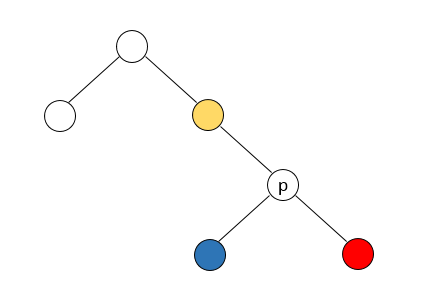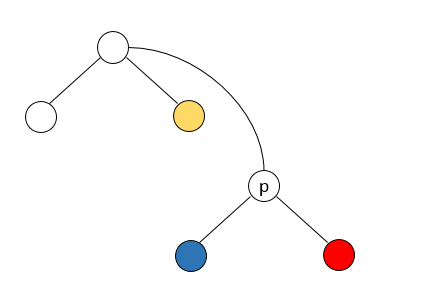今天突然想打打splay,结果发现以前学的都忘光了,所以只能从头开始啦~
splay是基于二叉搜索树的结构,通过旋转来完成各种操作。
所以splay的基本性质:
左儿子的权值都小于父节点的权值, 右儿子的权值都大于父节点的权值
splay的功能:
询问数的排名,查询k大的数,查询一个数的前驱和后继
时间复杂度均摊O(log n)
关于splay的具体实现:
结构体里
struct node
{
node *ch[2], *f;
int sz, cnt, v;
void maintain()
{
sz = cnt + ch[0] -> sz + ch[1] -> sz;
}
int cmp(int x)
{
if(x == v) return -1;
return x < v ? 0 : 1;
}
int dir()
{
return f -> ch[1] == this;
}
void setc(node *x, int d)
{
(ch[d] = x) -> f = this;
}
}T[SZ], *root, *null;各成员函数的作用:
maintain():用来更新子树大小和当前数值的个数
cmp() :比较x和当前节权值的大小,以便继续向儿子方向转移
dir() :如果当前节点是右儿子则返回真,否则返回假
setc() : 把x置为当前节点的左儿子或右儿子
关于插入操作:
void insert(node *p, int x)
{
if(root == null) //如果树为空,直接插入
{
root = newnode(x, null);
return ;
}
while(p != null)
{
p -> sz++;
int d = p -> cmp(x);
if(d == -1) //要插入的值与当前节点的值相等
{
p -> cnt++;
break;
}
if(p -> ch[d] == null) //没有儿子了,直接插入
{
p -> ch[d] = newnode(x, p);
p = p -> ch[d];
break;
}
p = p -> ch[d];
}
splay(p); //把p旋转至根节点位置
}关于删除操作:
void erase(node *p, int x)
{
while(p != null)
{
p -> sz--;
int d = p -> cmp(x);
if(d == -1)
{
p -> cnt--;
break;
}
p = p -> ch[d];
} //找到x的过程
if(p -> cnt) return ; //如果x不只一个,直接返回
splay(p); //将x旋转至根节点处
if(p -> ch[0] == null) //如果没有左儿子,则右儿子做根节点
{
root = p -> ch[1];
root -> f = null;
return ;
}
if(p -> ch[1] == null) //如果没有右儿子,左儿子做根节点
{
root = p -> ch[0];
root -> f = null;
return ;
}
p = p -> ch[0]; //需要满足基本性质
while(p -> ch[1] != null) p = p -> ch[1];
splay(p, root);
p -> ch[1] = root -> ch[1];
p -> ch[1] -> f = p;
p -> f = null;
p -> maintain();
root = p;
}重头戏!!!splay() 和 rotate()!
void splay(node *p, node *rt = null)
{
while(p -> f != rt)
{
if(p -> f -> f == rt) //若p的父亲为根节点,直接旋转
rotate(p);
else
{
if(p -> dir() == p -> f -> dir()) //p与它的父亲均为左儿子或右儿子
rotate(p -> f), rotate(p);
else rotate(p), rotate(p); //否则 连续旋转两次p
}
}
p -> maintain(); //更新节点
}void rotate(node *p)
{
node *fa = p -> f;
int d = p -> dir();
fa -> f -> setc(p, fa -> dir());
fa -> setc(p -> ch[d ^ 1], d);
fa -> maintain();
p -> setc(fa, d ^ 1);
p -> maintain();
if(fa == root) root = p;
}之前一直搞不懂结构体里的setc()函数,现在终于理解了。
模拟rotate()的过程:
当前节点为p,p的父节点为黄色,p的左儿子为蓝色,右儿子为红色
首先将p的父节点置为原父节点的父节点
将p的右儿子置为原父节点的右儿子,以保证满足基本性质
将p的原父节点置为p的左儿子
大功告成!
关于查询操作:
int ask_rank(node *p, int x) //查询一个数的排名
{
int ans = 0;
while(p != null)
{
int d = p -> cmp(x);
if(d == -1) return ans + p -> ch[0] -> sz + 1;
if(d == 1) ans += p -> ch[0] -> sz + p -> cnt;
p = p -> ch[d];
}
return -1;
}
int ask_num(node *p, int k) //查询k大的数
{
while(p != null)
{
int l = p -> ch[0] -> sz + 1;
int r = p -> ch[0] -> sz + p -> cnt;
if(l <= k && k <= r) return p -> v;
if(k > r) k -= r, p = p -> ch[1];
else p = p -> ch[0];
}
}
int ask_pre(node *p, int x) //查询前驱
{
int ans = 0;
while(p != null)
{
if(p -> v < x) ans = p -> v, p = p -> ch[1];
else p = p -> ch[0];
}
return ans;
}
int ask_suf(node *p, int x) //查询后继
{
int ans = 0;
while(p != null)
{
if(p -> v > x) ans = p -> v, p = p -> ch[0];
else p = p -> ch[1];
}
return ans;
}最后附一份完整的模板 PS:以BZOJ 3224 为例题
#include <iostream>
#include <cstdio>
#include <algorithm>
using namespace std;
typedef long long LL;
const int SZ = 1000010;
const int INF = 1e9 + 10;
struct node
{
node *ch[2], *f;
int sz, cnt, v;
void maintain()
{
sz = cnt + ch[0] -> sz + ch[1] -> sz;
}
int cmp(int x)
{
if(x == v) return -1;
return x < v ? 0 : 1;
}
int dir()
{
return f -> ch[1] == this;
}
void setc(node *x, int d)
{
(ch[d] = x) -> f = this;
}
}T[SZ], *root, *null;
int Tcnt = 0;
node* newnode(int x, node *f)
{
node *k = T + (++Tcnt);
k -> v = x;
k -> ch[0] = k -> ch[1] = null;
k -> sz = k -> cnt = 1;
k -> f = f;
return k;
}
void rotate(node *p)
{
node *fa = p -> f;
int d = p -> dir();
fa -> f -> setc(p, fa -> dir());
fa -> setc(p -> ch[d ^ 1], d);
fa -> maintain();
p -> setc(fa, d ^ 1);
p -> maintain();
if(fa == root) root = p;
}
void splay(node *p, node *rt = null)
{
while(p -> f != rt)
{
if(p -> f -> f == rt) //若p的父亲为根节点,直接旋转
rotate(p);
else
{
if(p -> dir() == p -> f -> dir()) //p与它的父亲均为左儿子或右儿子
rotate(p -> f), rotate(p);
else rotate(p), rotate(p); //否则
}
}
p -> maintain(); //更新节点
}
void insert(node *p, int x)
{
if(root == null) //如果树为空,直接加入
{
root = newnode(x, null);
return ;
}
while(p != null)
{
p -> sz++;
int d = p -> cmp(x);
if(d == -1) //要插入的值与当前节点的值相等
{
p -> cnt++;
break;
}
if(p -> ch[d] == null) //没有儿子了,直接加入
{
p -> ch[d] = newnode(x, p);
p = p -> ch[d];
break;
}
p = p -> ch[d];
}
splay(p); //把p旋转至根节点位置
}
//RE:从零开始的数据结构生活
void erase(node *p, int x)
{
while(p != null)
{
p -> sz--;
int d = p -> cmp(x);
if(d == -1)
{
p -> cnt--;
break;
}
p = p -> ch[d];
}
if(p -> cnt) return ;
splay(p);
if(p -> ch[0] == null)
{
root = p -> ch[1];
root -> f = null;
return ;
}
if(p -> ch[1] == null)
{
root = p -> ch[0];
root -> f = null;
return ;
}
p = p -> ch[0];
while(p -> ch[1] != null) p = p -> ch[1];
splay(p, root);
p -> ch[1] = root -> ch[1];
p -> ch[1] -> f = p;
p -> f = null;
p -> maintain();
root = p;
}
int ask_rank(node *p, int x)
{
int ans = 0;
while(p != null)
{
int d = p -> cmp(x);
if(d == -1) return ans + p -> ch[0] -> sz + 1;
if(d == 1) ans += p -> ch[0] -> sz + p -> cnt;
p = p -> ch[d];
}
return -1;
}
int ask_num(node *p, int k)
{
while(p != null)
{
int l = p -> ch[0] -> sz + 1;
int r = p -> ch[0] -> sz + p -> cnt;
if(l <= k && k <= r) return p -> v;
if(k > r) k -= r, p = p -> ch[1];
else p = p -> ch[0];
}
}
int ask_pre(node *p, int x)
{
int ans = 0;
while(p != null)
{
if(p -> v < x) ans = p -> v, p = p -> ch[1];
else p = p -> ch[0];
}
return ans;
}
int ask_suf(node *p, int x)
{
int ans = 0;
while(p != null)
{
if(p -> v > x) ans = p -> v, p = p -> ch[0];
else p = p -> ch[1];
}
return ans;
}
void init() //初始化
{
null = newnode(-INF, null); //null为根
null -> sz = null -> cnt = 0;
root = null;
}
int main()
{
init();
int n;
scanf("%d", &n);
while(n--)
{
int op, x;
scanf("%d%d", &op, &x);
switch(op)
{
case 1 : insert(root, x); break;
case 2 : erase(root, x); break;
case 3 : printf("%d\n", ask_rank(root, x)); break;
case 4 : printf("%d\n", ask_num(root, x)); break;
case 5 : printf("%d\n", ask_pre(root, x)); break;
case 6 : printf("%d\n", ask_suf(root, x)); break;
}
}
return 0;
}























 402
402











 被折叠的 条评论
为什么被折叠?
被折叠的 条评论
为什么被折叠?








